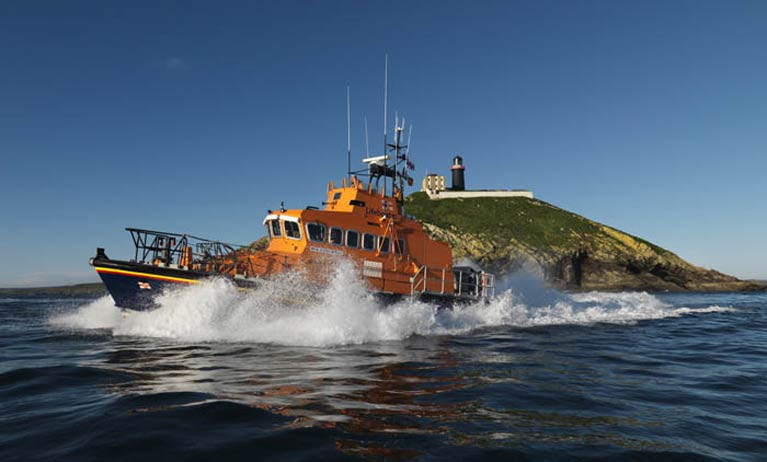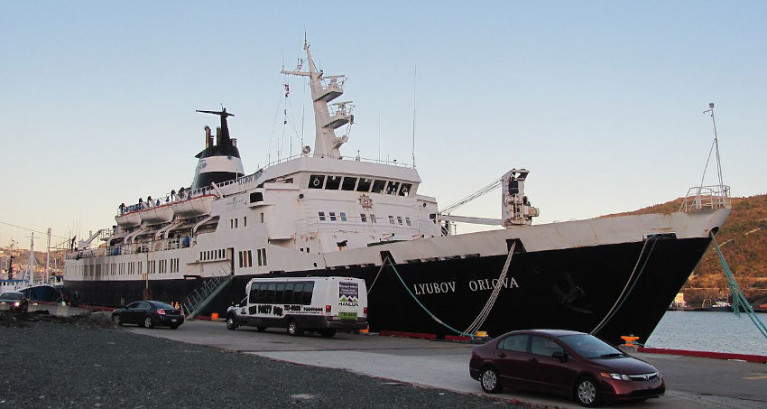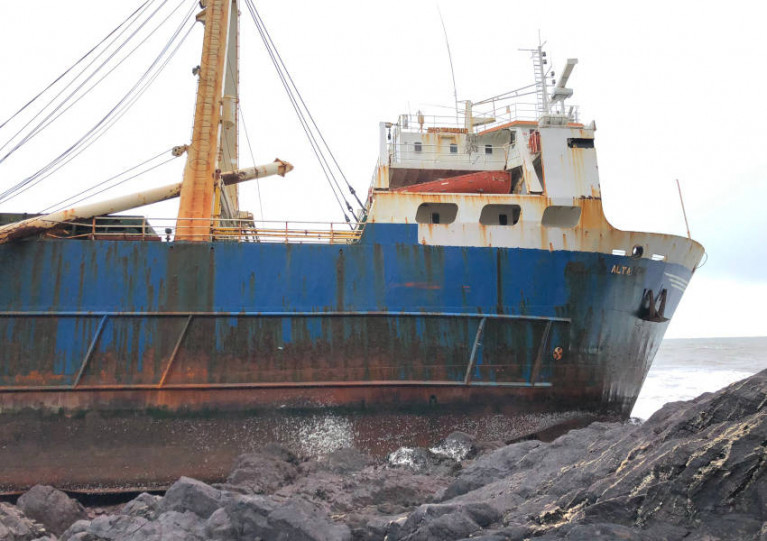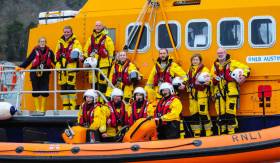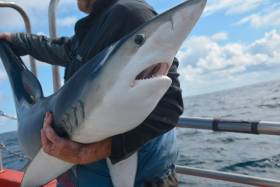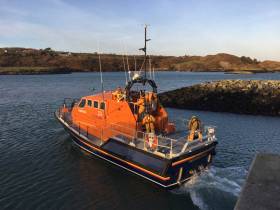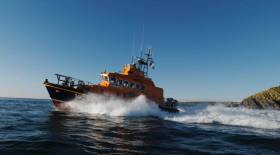Displaying items by tag: Ballycotton
Ballycotton RNLI Brings Yacht with Two Crew Onboard to Safety After Engine Failure off Roche’s Point
A 36ft yacht with two people onboard that had suffered engine failure south of Roche’s Point yesterday (Wednesday, 20 July), was brought to safety by lifeboat crew from Ballycotton RNLI.
Ballycotton RNLI was requested to launch by Valentia Coast Guard at 4.20 pm when a yacht suffered engine failure. The vessel had been en route to Crosshaven in Cork Harbour.
Conditions were calm and once on scene, lifeboat crew assessed the situation before establishing a tow and bringing the yacht to the nearest safe port, which was Crosshaven.
Commenting on the callout Ballycotton RNLI Lifeboat Operations Manager Jerry Lynch said, ‘Thankfully conditions were perfect for the callout. With the recent good weather we have seen an increase in people out enjoying the water. We would advise people to take the correct water safety advice for the activity they are taking part in to always make sure they have a means of raising the alarm if things go wrong.’
Report of Possible Upturned Vessel Prompts Ballycotton Lifeboat Launch
Ballycotton RNLI’s all-weather Trent class lifeboat Austin Lidbury was called out by Valentia Coast Guard to a report from a passing yacht of a possible upturned boat south of Nohaval.
Conditions were fresh with Force 6-7 south-westerly winds and clear visibility when the lifeboat launched at 2.20pm yesterday afternoon (Sunday 24 October).
Two miles west of Daunt Rock, the lifeboat crew discovered the remains of an old boat with its hull upturned in the water. It is believed it may have been washed out to sea as a result of recent storms.
Ballycotton RNLI duty coxswain Barry Murphy said: “Thankfully this was a false alarm, and the call was made with good intent. The RNLI would always ask members of the public to call 999/112 if they feel somebody is in possible danger.”
All crew from Ballycotton RNLI returned safely at 5.20pm to refuel and wash down in preparation for the next callout.
Ballycotton RNLI Tow Fishing Vessel Home to Cork Harbour
Ballycotton RNLI all-weather Trent class lifeboat the Austin Lidbury was tasked by Valentia Coast Guard at 11.25 am yesterday to a report of a fishing vessel with engine failure approximately 5 miles off Flat Head, south of Cork Harbour.
Conditions were fresh with a strong 5/6 knot easterly wind and clear visibility.
Volunteer lifeboat crew with Ballycotton RNLI arrived at the scene at approximately 11.50 am where they found the 13-metre catamaran fishing vessel being held in position by another fishing vessel. The crew of Ballycotton RNLI secured the vessel, ensuring the two crew on board the boat were safe and then proceeded to tow the boat into Cork dockyard where it was moored safely.
Speaking following the callout, Peter O' Shea Ballycotton RNLI Mechanic said “On arrival, the fishing vessel was being held in position by another fishing boat. If they had not be able to secure a line to the boat it would have most likely ended up on the rocks due to the strong easterly winds. By towing the vessel to safety the outcome was positive for all involved”.
Broken down RIB
As the crew of Ballycotton RNLI prepared to return to the station they were alerted by radio to a report of a 6.5-metre semi-rigid pleasure boat with engine trouble anchored in Cobh harbour with two people on board. Ballycotton RNLI secured the boat and towed it into Cobh where it was safely brought alongside the pontoon and secured. The two people on board were both wearing lifejackets and had a radio which they used to call for assistance.
All crew from Ballycotton RNLI returned safely at 4.00 pm.
Ballycotton RNLI Crew:
- Mike Hallihan - Coxswain
- Peter O’Shea - Mechanic
- Claire McCarthy
- Eolan Breathnac
- Sile Scanlon
- Mike Kenneally
- Ciaran Walsh
Ballycotton RNLI in East Cork was launched at 7.30 pm this evening following a request from Valentia Coastguard to a report of two swimmers thought to be missing off Garryvoe beach approx. two miles west of Ballycotton by a concerned member of the public.
Conditions were good with clear visibility.
Ballycotton RNLI all-weather Trent class lifeboat Austin Lidbury and its boarding boat carried out an extensive search between Arhnahinch and Garryvoe beach.
Two members of the volunteer crew from the boarding boat went ashore and spoke with several members of the public. No sign of the swimmers was found and it is believed they had returned to shore and the call-out was treated as a false alarm with good intent.
All crew from Ballycotton RNLI returned safely at 9.00 pm.
We would remind everyone to respect the water, to understand the risks and to stay safe. Never swim alone. If you see someone in trouble, dial 999 and ask for the coastguard. Consider wearing a wetsuit and bright coloured hat and safety buoy for longer swims.
Ireland needs to appoint a Secretary of State’s Representative to deal with any future maritime or shipping incidents similar to the beaching of the MV Alta, a maritime expert advises.
Captain Neil Forde, a maritime consultant with Marine Hazard Ltd, tells the Irish Examiner that the ‘ghost ship’ which ran around in Ballycotton at the weekend is proving to be an “insurmountable bureaucratic obstacle” to measures to deal with the cargo ship, which underwent an environmental assessment yesterday (Tuesday 18 February).
“We are going to have a major maritime incident at some point, it is just inevitable … The county council, who even with the best will and intention is only going to be able to deal with small incidents, has been pushed into dealing with this by the current legislation,” he said.
Another ‘ghost ship’, the MV Lyobov Orlova — its decks infested with ‘cannibal’ rats — could pose a biohazard threat to Ireland if it reached these shores.
A straightforward solution, Capt Forde suggests, is to appoint a single expert whose “job is to say to the different agencies ‘you are going to do this’, no ifs or buts about it, and to deal with the situation quickly”.
The Irish Examiner has more on the story HERE.
Abandoned Cargo Ship ‘Alta’ Runs Aground On Cork Coast
Ballycotton Sea Adventures is reporting that a cargo ship abandoned at sea for more than a year has run aground on the Cork coastline during Storm Dennis, writes Tom MacSweeney.
An initial Irish Coast Guard inspection of the 'ghost ship' from the air reports no signs of pollution so far from the 80-metre vessel, which lies three miles west of Ballycotton.
The Irish Coast Guard's Twitter account posted video recorded from its Rescue 117 helicopter based in Waterford which was tasked to the location.
Rescue 117 was tasked earlier today to a vessel aground near Ballycotton, Cork. There was nobody on board. Previously the @USCG had rescued the 10 crew members from the vessel back in September 2018. The vessel has been drifting since and today came ashore on the Cork coastline. pic.twitter.com/NbvlZ89KSY
— Irish Coast Guard (@IrishCoastGuard) February 16, 2020
Alta was some 1,500km off West Africa in the autumn of 2018 when its crew abandoned ship, and it remained lost at sea until September last year when it was spotted by the Royal Navy in the middle of the Atlantic.
RTÉ News has more on this breaking story HERE.
During #StormDenis this 80 metre vessel 'The Alta' washed up 3 miles west of #Ballycotton. It was cargo vessel that was abandoned in South East Bermuda in October 2018.
— Ballycotton Sea Adv (@BCSeaAdventures) February 16, 2020
The vessel last spotted off the coast of West Africa in September 2019 and has been wandering seas until today pic.twitter.com/6jUsdpbzy9
Cork Lifeboat Crews To Share Their Lifesaving Stories This Wednesday On RTÉ’s Nationwide
Volunteer lifeboat crews from Crosshaven and Ballycotton RNLI in Cork will share their own stories of how they got involved with the lifesaving charity on TV for RTÉ One’s Nationwide this coming Wednesday 18 December.
And the two stations will also carry out a joint exercise to recover an unconscious casualty from the water, as they appeal to the public to support the RNLI’s ‘Perfect Storm’ fundraising campaign.
In Crosshaven, local business owners Aoife Dinan, of Rejuvenate beauty salon, and Denis Cronin of the popular Cronin’s Bar both volunteer for the Cork Harbour village’s lifeboat crew.
Denis was a keen surfer before he volunteered for the lifeboat and now answers the pager by jumping on his pushbike and heading to the station a couple of minutes away.
Aoife and her partner lost a close friend to drowning and she is now an active member of the lifeboat crew, often running from her business to make callouts at the station.
Best friends Molly Murphy and Caoimhe Foster joined the lifeboat together when they were in fifth year in school. They speak about what it was like to rush out of the classroom and down to the lifeboat station for a callout and to leave their schoolmates behind.
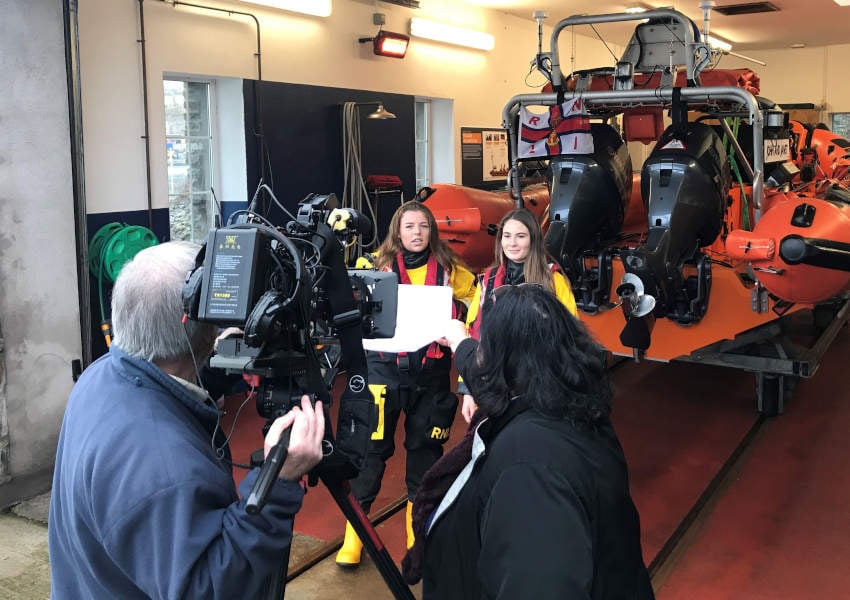 Crosshaven RNLI volunteers and best friends Molly and Caoimhe face the RTÉ Nationwide camera | Photo: RNLI/Niamh Stephenson
Crosshaven RNLI volunteers and best friends Molly and Caoimhe face the RTÉ Nationwide camera | Photo: RNLI/Niamh Stephenson
Ballycotton RNLI crew member Alan Cott lost his brother Glynn when the Maggie B sank in 2006. He is very proud of his involvement with the lifeboat and is honouring the memory of his brother in the work he does to save lives at sea.
Speaking about the programme and the launch of the Perfect Storm appeal by the RNLI, area lifesaving manager Brian O’Driscoll said: “Our lifeboat crew are what is best in the RNLI. These men and women give up their time to train and launch lifeboats in all weathers and to all types of situations.
“Our thanks to the Nationwide team for visiting two of our Cork lifeboat stations and speaking to our volunteer lifeboat crew about why they do it and what they get out of it.
“Many people don’t realise that the RNLI is a charity and we depend on the generosity of the public to continue with our work saving lives at sea.
“Aoife, Denis, Alan, Molly and Caoimhe give their time and their passion to the RNLI and in return they get the training, skills and equipment to be able to help those in trouble at sea. We are very grateful for the support of the public and we don’t take it for granted.”
To support the RNLI’s Perfect Storm appeal this Christmas, helping to ensure the charity’s brave volunteers can continue saving lives at sea, visit RNLI.org/ThePerfectStorm
A four-day shark festival with a €250,000 prize fund is set to put Ballycotton on the sea angling map later this year.
In his latest Angling Notes for The Irish Times, Derek Evans says the Ballycotton Big Fish from 12-15 September will be the biggest festival of its kind in Europe.
The event is the brainchild of Ballycotton-born Pearse Flynn, an experienced deep-sea angler who was determined to attract the world’s top competitors to an East Cork town already renowned for its big fish records.
Prizes are set to be awarded for biggest shark landed, as well as for the boat that lands the greater number of sharks ever the course of the tournament.
But only big spending anglers need apply, as the entry fee is a whopping €5,000 per head.
The Irish Times has more on the story HERE.
Baltimore Lifeboat Called Out To Search For Missing Swimmer
#RNLI - Baltimore RNLI launched yesterday morning (Tuesday 11 September) to a swimmer reported missing on a swim from Skibbereen to Baltimore in West Cork.
The inshore lifeboat was called to search the Ilen River for the swimmer after a safety boat lost visual contact with him during a squall north of Inishbeg.
Within an hour they were joined by the all-weather lifeboat to search the narrower channels of the river. Toe Head Coast Guard and the Shannon-based Irish Coast Guard helicopter Rescue 115 also assisted.
Some 40 minutes later, at 11.10am, Mizen Head Coast Guard informed all rescue agencies that the swimmer had made his way safely to shore, and all were to stand down.
“This was a great example of multiple rescue agencies working together and thankfully ended with a good outcome,” said Baltimore RNLI press officer Kate Callanan.
Elsewhere in Cork, Ballycotton RNLI launched both their all-weather and inshore lifeboats on Friday afternoon (7 September) to a capsized small sailing dinghy off Ballynamona beach.
A concerned member of the public had witnessed the casualty having difficulty righting the capsized dinghy, which was some 400 metres from the beach.
The crew on board the inshore lifeboat located the casualty in the water approximately 80m from the scene attempting to swim ashore.
The male casualty, believed to have been in the water for nearly 30 minutes, was brought onboard the inshore lifeboat and transferred to the larger all-weather vessel where he was administered first aid, then brought ashore where a local doctor and ambulance crew were waiting to assist.
“Thanks to the vigilance and very quick thinking of the local members of the public, they contributed to a speedy recovery with a positive outcome for all involved,” said Ballycotton RNLI coxswain Eolan Walsh.
Ballycotton Lifeboat In Medevac From Ferry Off East Cork Coast
#RNLI - Ballycotton RNLI launched their all-weather lifeboat on Saturday evening (4 August) around 7.20pm to a crew member on board the Pont-Aven cruise ferry.
The female casualty, who became injured while working on the vessel, required a medevac while 30 miles off Ballycotton Bay.
Ballycotton RNLI and its volunteer crew were launched on request by Valentia Coast Guard and proceeded to the incident.
The Pont-Aven altered its course back towards Cork Harbour and was met by Ballycotton RNLI some 16 miles out. The casualty was transferred to Ballycotton’s all-weather lifeboat and brought to Crosshaven where the ambulance service was waiting to assist.
Weather conditions were favourable, and near perfect for the task which enabled all involved to transfer the casualty quickly and seamlessly.
Speaking following the callout, Ballycotton RNLI coxswain Eolan Walsh said: “The timeliness and transfer of the casualty was made so much simpler by the professionalism of the Pont-Aven’s fast rescue boat crew.
“We would like to thank all involved that contributed to a positive outcome and we wish the casualty a speedy recover from all at Ballycotton RNLI.”


























